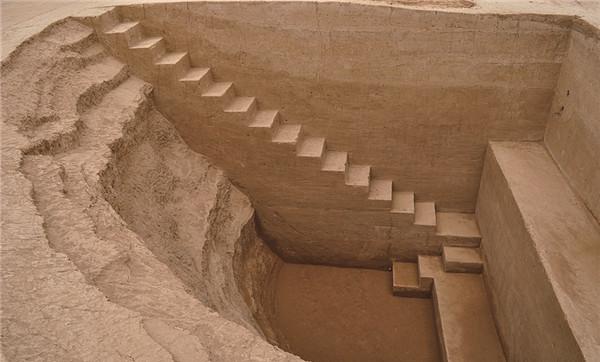
Excavated silos
In the just-concluded hit drama "Wind Rises Luoyang", the villain forces blew up Han Jiacang, causing panic among the people in the Shendu City. Hanjiacang was the largest national granary used in the Tang Dynasty, and before that, there was another national granary in Luoyang In the Sui Dynasty, which once became the focus of contention for various people, that is, Huiluocang.
Huiluocang was built in the early years of the Sui Dynasty, destroyed in the peasant war at the end of the Sui Dynasty, used for a relatively short time, and then gradually abandoned and buried in the ground, and its ruins are located near the current Xiaoli Village in Yinghe Township, Yinghe District. In 2004, the city planned to build a factory here, in the early stage of cultural relics archaeological survey work, found that 71 warehouses remained, they are arranged in a regular and orderly manner, the shape is larger, built for the same period, archaeologists speculate that it should belong to the national grain depot.
Arrows
In the three warehouses excavated in the early stage, archaeologists found that the excavated relics were dated from the Sui to the early Tang Dynasty, and after analyzing and judging the strata, experts initially speculated that the age of the three warehouses was not later than that of the early Tang Dynasty. Subsequently, in the Sui Dynasty ash pit in the ruins area, relics such as Sui Dynasty chronological inscription bricks were unearthed. Judging from the text content on the inscription bricks, the inscription details the institution that manages the warehouse as the "Taicang Bureau", and also records the quantity of grain stored in each warehouse, the source of grain, the specific location of the warehouse in the warehouse city, as well as the year, month, and day of the grain being stored, and the names of officials related to the grain in various places. Moreover, this place is basically consistent with the general location of the Huiluocang recorded in the literature, and the age of abandonment is basically the same, and archaeologists have finally determined that this site is the Huiluocang site of the Sui Dynasty.
The Zizhi Tongjian records that "in December of the second year of Emperor Zhao's reign (606 AD), he placed Luocang back in the northern seven miles of Luoyang..." As the closest granary to the capital of the Sui Dynasty, it was not only used to ensure the supply of grain and materials in Luoyang City, but also as a material transit station and reserve depot for the operation of the entire Grand Canal. How big is such an important warehouse?
Five baht
Archaeological excavations have revealed the mystery to everyone. Wang Ju, a researcher at the Municipal Institute of Cultural Relics and Archaeology, introduced that on the whole, Huiluocang City is rectangular, with an east-west length of 1140 meters and a north-south width of 355 meters, which is divided into several parts: the central management area, the warehouse area on the east and west sides, the road and the canal. Within the scope of the planned excavation, archaeologists drilled a total of 169 well-arranged cellars, plus the cellars drilled in other areas, and the number of cellars that have been determined has reached 221. According to the calculation of the distribution law of the warehouse, the number of warehouses in the whole warehouse should be about 700.
How much food can be loaded here? Archaeologists speculated. At present, the 7 warehouses that have been excavated are basically the same shape and size, with a diameter of 10 meters, a bottom diameter of 7 meters, a depth of 7 meters to 8 meters, and each warehouse can store about 500,000 catties of grain. If calculated according to 700 warehouses, the total grain storage can reach 350 million catties, which can be called a "super granary".
A park of archaeological sites built
In 2013, as an important part of the Sui-Tang Grand Canal, the Huiluocang site was announced by the State Council as a national key cultural relics protection unit. Wang Ju said that the complete cangcheng pattern and many warehouses in Huiluocang reflect the prosperity of the Grand Canal in the Sui Dynasty and the construction of corresponding storage facilities directly under the state, which is a physical example of the Sui and Tang Grand Canal centered on Luoyang, and also provides an important basis for the Sui and Tang Grand Canal to declare world cultural heritage.
In June 2014, Huiluocang was successfully listed on the World Cultural Heritage List. At present, an archaeological site park integrating culture, leisure and tourism has been built here. (Luo Bao Rong Media Reporter Wisdom Correspondent Hao Juntao The pictures in this group are all information pictures, provided by the Municipal Institute of Cultural Relics and Archaeology)